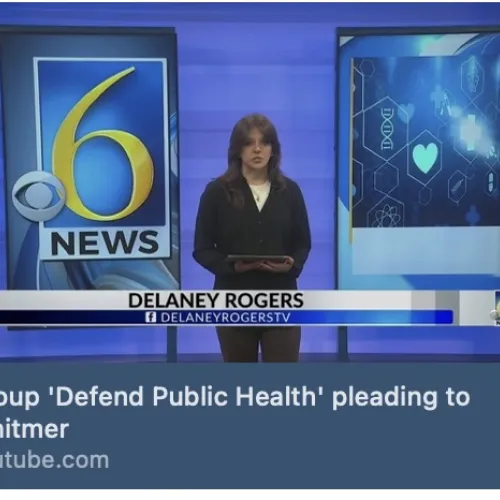Opinion
September 15, 2025
Without Vaccines, Long COVID Will Be Our Next Public Health Crisis
Without Vaccines, Long COVID Will Be Our Next Public Health Crisis
By: Beth Linas, PhD, MHS
A recent Daily Beast article reported that the U.S. government may soon pull COVID-19 mRNA vaccines from the market. A close associate of HHS Secretary RFK Jr. even suggested they could disappear “within months.” A few days later the FDA announced who was eligible for the 2025/2026 COVID-19 vaccines which include Adults 65 and older and individuals ages 6 months to 64 years with at least one high-risk underlying health condition (e.g. chronic kidney disease, lung disease, diabetes, heart conditions, HIV, obesity, etc). A full list can be found here. If you do not meet these criteria, you will not be permitted to get a COVID-19 vaccine without a prescription.
This is shocking. During his first term, President Trump proudly championed Operation Warp Speed, the historic public–private partnership that delivered safe and effective COVID-19 vaccines in record time. This was one of his administration’s signature achievements. By limiting access to these vaccines now, he is dismantling his own legacy. Even more troubling are the lives put at risk. With fewer people vaccinated, severe illness, hospitalization, and deaths will rise, while the immune system is left unprepared to fight the virus. The virus could spread more freely, and the chances of new, dangerous variants increase. This isn’t just about individual choice—it’s about protecting the public.
It’s worth remembering what a breakthrough these vaccines are. Known as “An Incredible Feat of Genomic Technology”, these vaccines were approved by the FDA less than a year after SARS-CoV-2 was identified. They are messenger (mRNA) vaccines, which means they deliver a small piece of genetic code to your cells that instructs them to make the spike protein of the SARS-CoV-2 virus. This protein is recognized by your body as foreign prompting a safe and effective immune response, so when you encounter the real virus, your body can recognize it quickly and fight it off. The mRNA itself is broken down quickly and doesn’t affect your DNA. In other words, mRNA vaccines are safe, effective, and one of the most important scientific achievements in our lifetime.
And while COVID-19 vaccines were developed and delivered in in what seemed like record time, the reality is that more than 50 years of public and private laboratory research laid the groundwork for the rapid development of these life-saving vaccines. While no vaccine is perfect, COVID-19 vaccines dramatically reduce risk of severe illness, hospitalization, and one of the most underappreciated dangers of this virus: Long COVID.
Long COVID is neither rare nor mild. It is a chronic condition characterized by a wide range of symptoms or conditions that occur at least three months after COVID-19 infection. In 2024, 7% of U.S. adults—roughly 17 million people—reported currently having Long COVID. Research suggests nearly 3 in 10 adults who contract COVID go on to develop lingering symptoms. And those symptoms are far from trivial: extreme fatigue, dizziness, post-exertional malaise, chest pain, and cognitive dysfunction are among the most common. Over 200 symptoms have been documented, and for many people, they never fully recover.
I’ve seen this reality up close. As the coordinator for several working groups of the NIH RECOVER Initiative—the largest national effort to study Long COVID—I worked alongside researchers, clinicians, and patients living with the condition. Patients’ voices guided the science, and week after week I heard their stories: exhaustion so profound they couldn’t climb stairs, memory lapses that derailed careers, symptoms that made daily life unrecognizable. Long COVID isn’t an abstract data point—it’s millions of people trying, and often failing, to get their lives back.
And the toll of Long COVID is not only medical, but also economic. Millions of Americans struggle to return to work long after initial infection. Nearly 1 in 10 Long COVID patients are unable to return to work within three months—twice the rate of those without lingering symptoms. The economic burden is staggering: conservative estimates put the total annual U.S. costs, including reduced quality of life and productivity loss, at more than $500 billion.
And here’s the most sobering reality: these numbers—the millions suffering from Long COVID, the staggering $500 billion annual economic burden, the lost productivity—come despite the protection of vaccines. We already know the damage COVID-19 can do even with widespread vaccination. What we don’t know is the scale of illness, disability, death, and economic collapse that could unfold without them. To reduce vaccine availability now is not just shortsighted, it’s reckless. The change in COVID-19 vaccination policies could further undermine public trust in health institutions and public health measures, widening health and economic disparities. Detrimental long-term impacts on trust in government and scientific institutions could reduce the uptake of future public health measures.
Reducing access to COVID-19 vaccines risks unleashing a second wave of preventable suffering and burdening our health system, economy, and communities for years to come.
Beth S. Linas, PhD, MHS is an infectious disease epidemiologist and member of Defend Public Health


